
Under the Whyte notation for the classification of steam locomotives, 4-6-2 represents the wheel arrangement of four leading wheels on two axles, six powered and coupled driving wheels on three axles and two trailing wheels on one axle. The 4-6-2 locomotive became almost globally known as a Pacific type after a New Zealand locomotive that was shipped across the Pacific Ocean.

Under the Whyte notation for the classification of steam locomotives, 4-8-2 represents the wheel arrangement of four leading wheels, eight powered and coupled driving wheels and two trailing wheels. This type of steam locomotive is commonly known as the Mountain type.

The Great Western Railway 2900 Class or Saint Class, which was built by the Great Western Railway's Swindon Works, incorporated several series of 2-cylinder passenger steam locomotives designed by George Jackson Churchward and built between 1902 and 1913 with differences in the dimensions. The majority of these were built as 4-6-0 locomotives; but thirteen examples were built as 4-4-2. They proved to be a highly successful class which established the design principles for GWR 2-cylinder classes over the next fifty years, and influenced similar classes on other British railways.
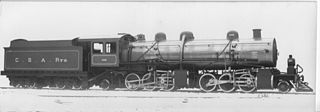
Under the Whyte notation for the classification of steam locomotives by wheel arrangement, a 2-6-6-2 is a locomotive with one pair of unpowered leading wheels, followed by two sets of three pairs of powered driving wheels and one pair of trailing wheels. The wheel arrangement was principally used on Mallet-type articulated locomotives, although some tank locomotive examples were also built. A Garratt locomotive or Golwé locomotive with the same wheel arrangement is designated 2-6-0+0-6-2 since both engine units are pivoting.
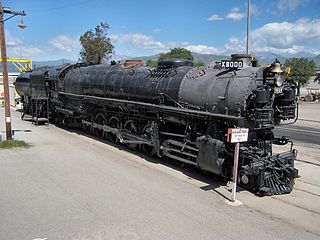
The Union Pacific Railroad 9000 Class was a class of 88 steam locomotives, built by ALCO for the Union Pacific between 1926 and 1930.
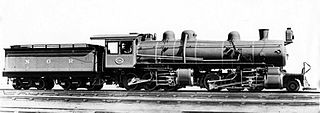
Under the Whyte notation for the classification of steam locomotives by wheel arrangement, 2-6-6-0 is a locomotive with one pair of unpowered leading wheels, followed by two sets of three pairs of powered driving wheels and no trailing wheels. The wheel arrangement was principally used on Mallet-type articulated locomotives. Some tank locomotive examples were also built, for which various suffixes to indicate the type of tank would be added to the wheel arrangement, for example 2-6-6-0T for an engine with side-tanks.
Class E6 on the Pennsylvania Railroad was the final type of 4-4-2 "Atlantic" locomotive built by the railroad, and second only to the Milwaukee Road's streamlined class A in size, speed and power. Although quickly ceding top-flight trains to the larger K4s Pacifics, the E6 remained a popular locomotive on lesser services and some lasted to the end of steam on the PRR. One, #460, called the Lindbergh Engine, is preserved at the Railroad Museum of Pennsylvania. It was moved indoors to begin preparations for restoration on March 17, 2010. On January 10, 2011, PRR #460 was moved to the museum's restoration shop for a two- to three-year project, estimated to cost $350,000. The engine is listed in the National Register of Historic Places.

Chicago and North Western 1385 is a preserved R-1 class 4-6-0 "Ten-Wheeler" steam locomotive built by the American Locomotive Company (ALCO) in March 1907 for the Chicago and North Western Railroad (C&NW). The locomotive was mainly used to operate the C&NW's freight trains until 1956, when it was retired from service. In 1961, the original members of the Mid-Continent Railway Museum (MCRM) purchased No. 1385 for $2,600 scrap value, and the locomotive was moved to the museum's original location in Hillsboro, Wisconsin.
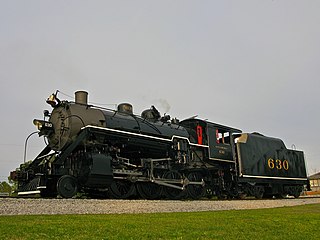
Southern Railway 630 is a 2-8-0 "Consolidation" type steam locomotive built in February 1904 by the American Locomotive Company (ALCO) of Richmond, Virginia for the Southern Railway as a member of the Ks-1 class. It is currently owned and operated by the Tennessee Valley Railroad Museum (TVRM) in Chattanooga, Tennessee where it resides today for use on excursion trains.

The South African Railways Class 10D 4-6-2 of 1910 was a steam locomotive from the pre-Union era in Transvaal.
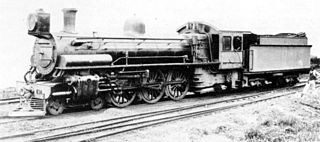
The South African Railways Class 10B 4-6-2 of 1910 was a steam locomotive from the pre-Union era in Transvaal.

The South African Railways Class 10A 4-6-2 of 1910 was a steam locomotive from the pre-Union era in Transvaal.

The South African Railways Class 8 4-8-0 of 1902 was a steam locomotive from the pre-Union era in the Cape of Good Hope.

The South African Railways Class 6L 4-6-0 of 1904 was a steam locomotive from the pre-Union era in the Cape of Good Hope.
The South African Railways Class 3A 4-8-2 of 1910 was a steam locomotive from the pre-Union era in the Colony of Natal.

The Chicago and North Western R-1 class was a class of 325 4-6-0 "Ten-Wheeler" steam locomotives built by the Schenectady Locomotive Works, the American Locomotive Company, and the Baldwin Locomotive Works from 1901 to 1908. The R-1 locomotives were so large and so heavy that the Chicago and North Western (C&NW) Railroad had to extensively rebuild their trackage, bridges, tunnels, turntables, and enginehouses to accommodate them.
The Chicago and North Western Railway class Z was a class of 251 American 2-8-0 locomotives. They were built between 1909 and 1913, when production switched to the larger class J 2-8-2 locomotives. The class letter spawned their nickname amongst C&NW and Omaha Road crews: "Zulu".
The Chicago and North Western Railway class J was a class of 310 American 2-8-2 locomotives. They were built between 1913 and 1923 by the American Locomotive Company. In addition, the Chicago, St. Paul, Minneapolis and Omaha Railway acquired 32, and also classified them as class J.

The Milwaukee Road S3 Class was a class of 10 4-8-4 "Northern" type steam locomotives built by the American Locomotive Company in 1944 and operated by the Milwaukee Road until the mid 1950s. The locomotives saw service in pulling freight and passenger trains throughout the Milwaukee Road.

Chicago and North Western 175 is a preserved R-1 class 4-6-0 "Ten-Wheeler" steam locomotive built by the American Locomotive Company (ALCO) in December 1908. The locomotive was used for pulling various passenger and freight trains throughout Wisconsin, until the Chicago and North Western (C&NW) Railroad ended commercial steam operations in 1957. In 1964, the locomotive was sold to Clint Jones, who had plans to use it on the Keweenaw Central Railroad for excursion service alongside Copper Range 2-8-0 No. 29, but restoration work was never completed under his ownership.

















